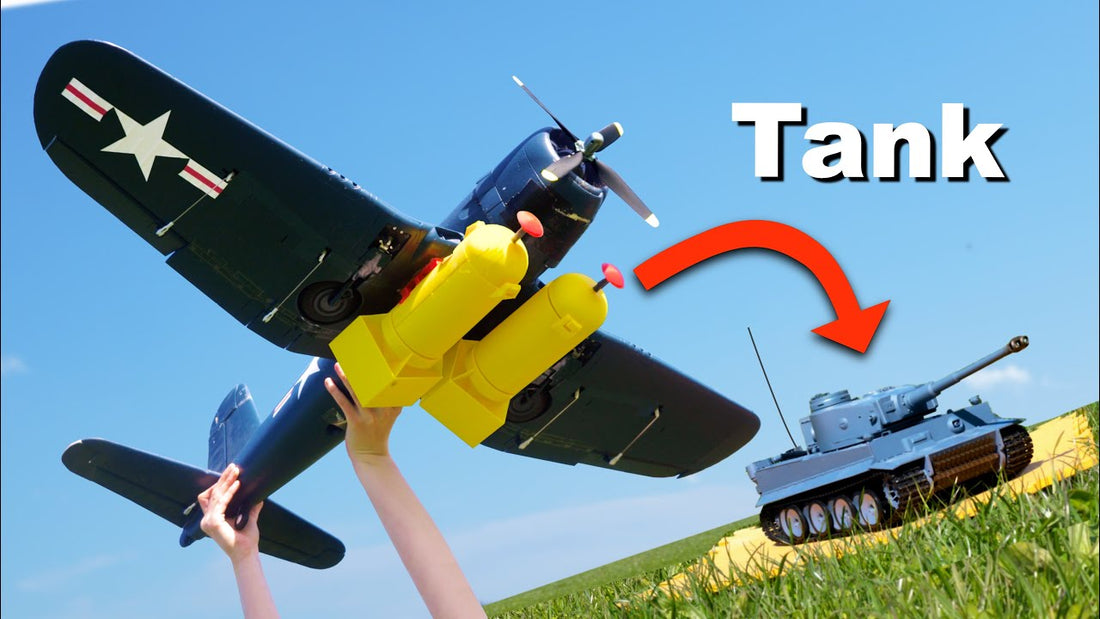Read what happened when I took an RC plane and modified it to carry two 3d printed flour bombs to see just how accurately I could drop them next to an RC tank.
Since flying remote control planes as a kid, I've always wanted to try this out! Check out the video below:
I wanted to see just how hard it is to hit a target using an RC plane just like a real WW2 mission, while using a cockpit mounted FPV camera to fly the plane from the cockpit, to get an appreciation of the skill and bravery of WW2 pilots.
Don’t try this at home - this was done in a safe controlled manner.
I first selected a suitable RC plane and decided on an E-Flite Corsair that I used in my RC aircraft carrier video, where I managed to land this plane on the deck without it ditching into the water. Check out that project here:
I also got myself a remote control RC Tiger I tank from Wonderland Models which was placed on the target to see how close we could get the bombs to land next to it.

Step 1
The first thing I did was 3D print a simple release mechanism for the plane on my Bambu Labs P1S 3D printer.
It worked using just one small 9g servo and a small push rod —super simple and reliable.

Next, I found a basic 3D-printable plastic bomb design on a website called Thingiverse.
I printed the bomb in a bright colour, glued it together, and attached everything to the plane.

Test 1
After our first test dropping our improvised bombs, we’d found the first problem of the project. Taking off was really tricky!
This plane is what’s called a “tail dragger,” which means it has two wheels at the front and one small wheel at the back.
The problem with this was that the plane wanted to flip over every time because of the rough grass.

Once in the air plane felt fine, so we lined up and tested if the drop mechanism worked.
The bombs dropped with a lot of spin, which made them fly all over the place. They were definitely not very accurate but the release process was successful none the less.

Step 2
We needed to come up with a better bomb design, something that would land accurately and show very clearly where we hit.
I found a clever 3D-printed bomb on Thingiverse. This one had a spring inside that made it pop open when it hit the ground. I printed a small version, and it looked promising.
If we could fill it with some sort of powder, it would leave a clear mark on the ground.


Our first thought was flour, but like any good engineers we researched a variety of options including colour festival Holi powder.


After a bit of testing, the most visually striking powders were the coloured Holi Powder, but we decided to go with icing sugar as it was lightweight and made a nice, clear poof when it hit the ground.

Of course we needed to make sure it didn’t make a permanent mess, but this stuff just melted away in the rain (which is sort of ever present here in the UK).
Finally we glued on some updated bomb drop mechanisms to hold these new bombs. These new mechanisms worked the same way but helped reduce any shaking during flight.

Test 2
We went for another test flight over some nice empty farm fields, to see how reliably the new bombs and bomb drop mechanisms worked in air.
Things went immediately wrong. On take-off a bomb and its release mechanism detached from the plane.

This caused some real issues as my plane was suddenly very lop sided with all of the weight of the heavy payload off centre, pulling me to the left.
I ditched the bomb over the empty farm field and thankfully the plane corrected itself, but at this point I still had the wind and an extremely challenging runway to contend with.
After a rocky landing involving a last minute decision to ditch my landing gear, we had our plane back in one piece.

Despite the first bomb assembly 'jumping ship' immediately, the second one had worked well to ditch the payload.
We’d made sure all of these fields were definitely empty before taking off, of course, as you should always be safe while flying model aircraft.

Step 3
I knew from past experience that to be able to fly the plane accurately at the target would require us to fit an FPV camera to this plane, to fly it from the cockpit.
To be able to reliably spot the tiny target in the field, I tried out a digital FPV system instead, which would be a much higher resolution.
For this I got a DJI Goggle set and linked it to a DJI video transmitter.

After bodging the system to run off a 2s battery, it seemed to be working, but the video transmitter used an enormous amount of power, meaning the whole thing got quite hot which was quite concerning.
The transmitter needed fast moving airflow over the top of it, and without it, the processor overheated in just a few minutes and promptly shut down.
If it did this while I was flying, I’d go completely blind and crash, which would probably lead to the failure of the project…
After we had this sort of working, I built the FPV cockpit with the camera mounted on a servo so I could look left and right down the wings of the plane for a good view.

Test 3
With some good weather for once, we could get everything ready in the field for test 3.
The tank was driven into position on its target safely away from the runway and the bombs loaded by payload specialist Emma and fitted to the strong release mechanisms under the Corsair, which was quite a fiddly job.

After another tricky take off, I had managed to get it off the grass airstrip without turning over, but it had been a close one!
After my first attempt, both bombs had been successfully released and had exploded but they were a couple of metres from our tank target.

With my flight battery now quite low, we brought the plane in to land, reloaded and inspected the target.
Attempt one ended with a rough landing and some damage to the landing gear but nothing we couldn't fix.
We tried a different flight pattern on attempt number 2 but unfortunately the bombs had gone too far again, missing the target by around 3m.

Over the next few attempts I tried varying angles of attack while flying in at the plane, also trying out different speeds.
Some went too long while other times I got blown sideways at the last second, making the payload go wide.

Between each run we had to make constant repairs to the fragile landing gear and one time on take-off I broke a prop, one of only two we had for the project.
We were running out of spares, daylight and hope.
As most of the time I’d been going long, we decided to try out a new strategy of aiming for an imaginary target just before the main target with our last battery of the day.
On the seventh and final mission of the day, I lined the Corsair up into the wind and opened the throttle just as before, with my goggles off.

The plane struggled to climb and I tried to pull my goggles on earlier into the flight, but then disaster…
As I took my hand off the controller, a gust of wind tipped the plane just as I had my goggles half across my face - I was nearly blind as the plane entered a dive…

As I walked to the plane, I had little hope it had survived, but I was to be pleasantly surprised.
Turned out, the damage wasn’t actually that bad - luckily, we could repair it and try again.

The next morning, the wind had died down and the conditions were perfect for a second day of attempts.
After another risky take-off we were back in the air once more. I lined up the target and dropped earlier than previous attempts. The bombs hit the target, throwing their clouds of icing sugar into the air. I couldn’t quite believe it!
Eight flights and we had finally achieved the aim of the project - hitting the target square on for a confirmed kill of the RC tank.

I think this shows that with some a bit of persistence, patience and and a lot of problem solving, its possible to overcome difficult challenges and achieve things you’ve always wanted to try.
If you enjoyed this challenge, there's plenty more to read over here!


2 comments
Can I buy a dive bomber?
Can I buy a dive bomber?